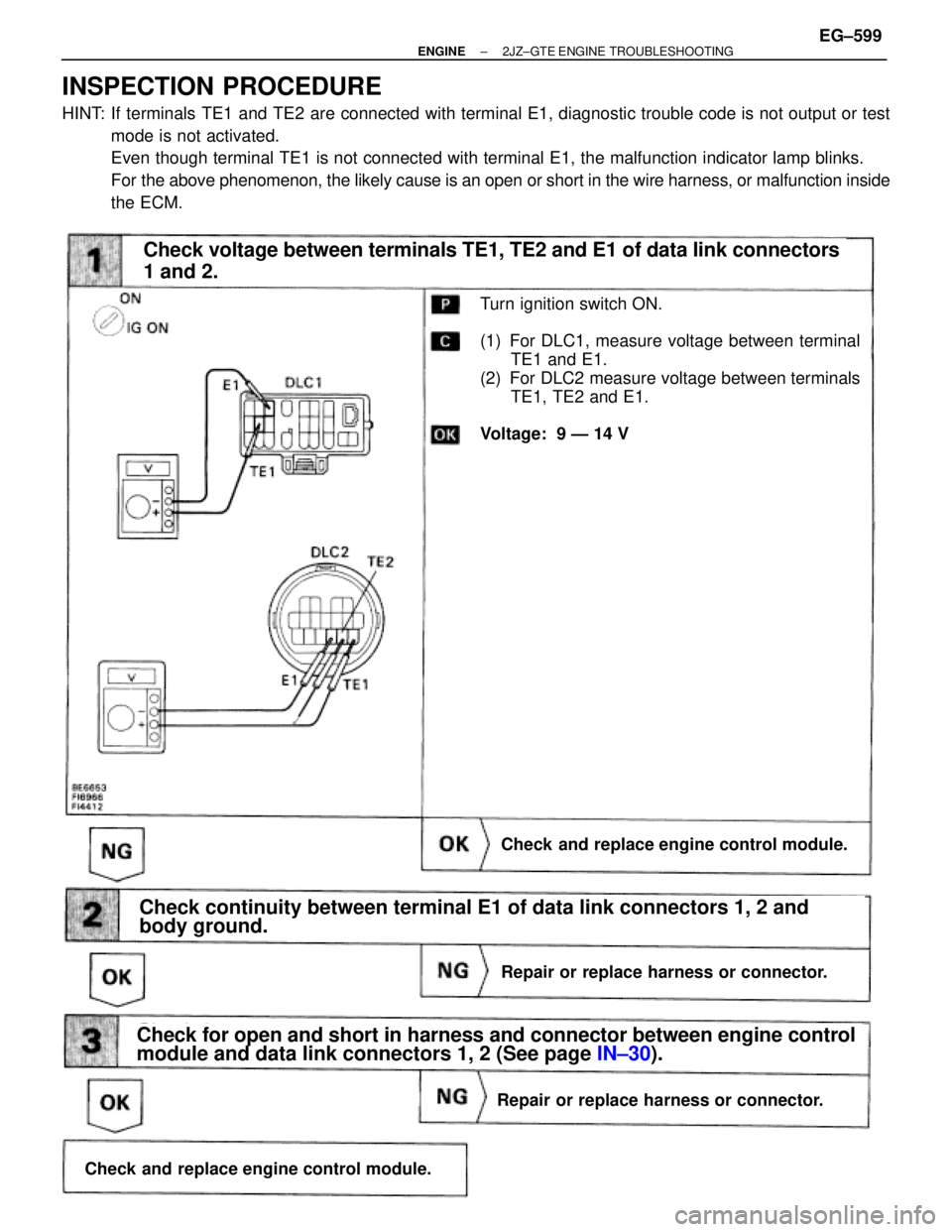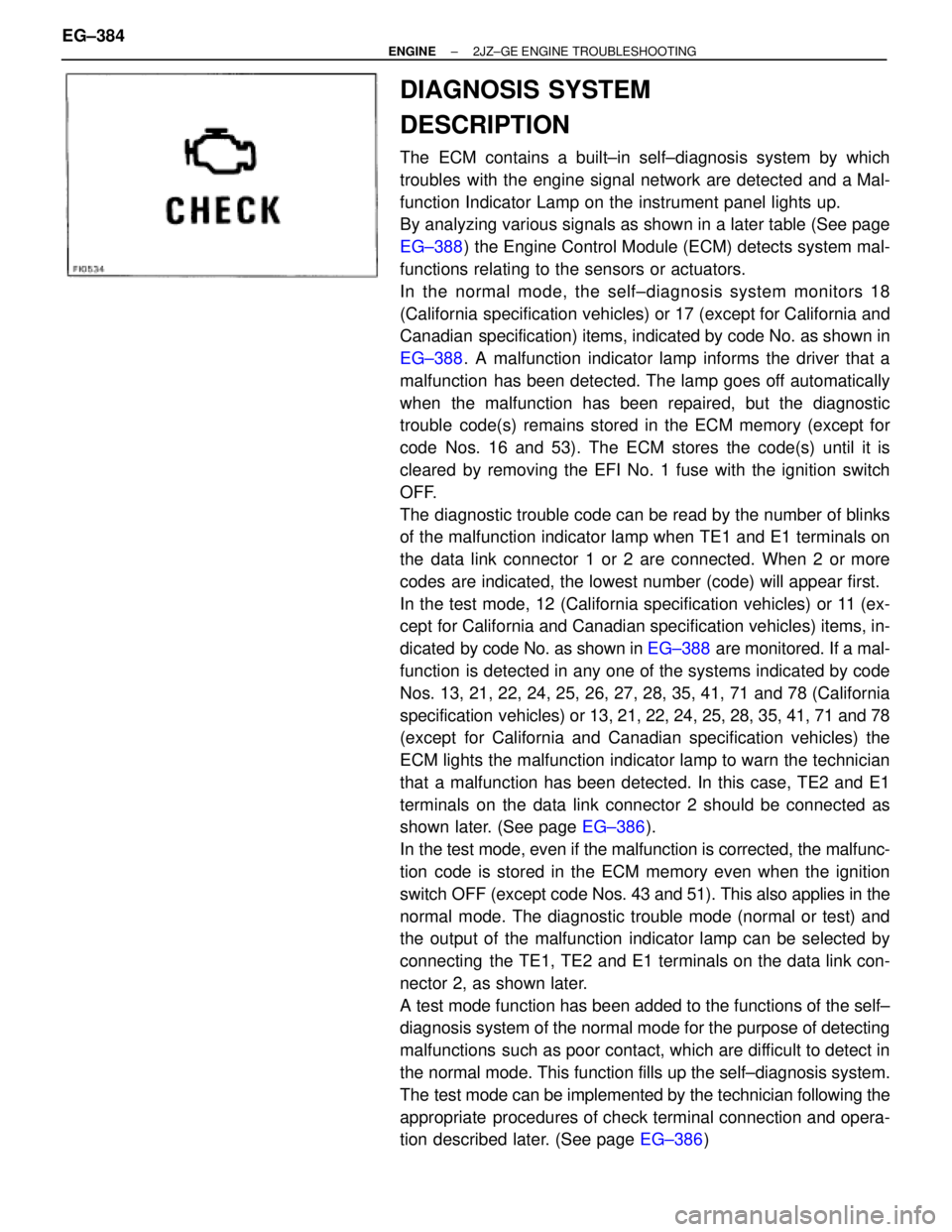Page 116 of 878
Check for short in the harness and all the compo-
nents connected to EFI No.1 fuse (See Electrical
Wiring Diagram).
Turn ignition switch ON.
Measure voltage between terminal M±REL of en-
gine control module connector and body ground.
Voltage: 9 Ð 14 V
Check voltage between terminal M±REL of engine control module connector
and body ground
Check EFI No.1 Fuse.
Remove EFI No.1 fuse from R/B No.2.
Check continuity of EFI No.1 fuse.
Continuity
Check and replace engine control module.
± ENGINE2JZ±GTE ENGINE TROUBLESHOOTINGEG±579
Page 118 of 878
Back Up Power Source Circuit
CIRCUIT DESCRIPTION
Battery positive voltage is supplied to terminal BATT of the ECM even when the ignition switch is off for use by
the diagnostic trouble code memory and air±fuel ratio adaptive control value memory, etc.
± ENGINE2JZ±GTE ENGINE TROUBLESHOOTINGEG±581
Page 119 of 878
INSPECTION PROCEDURE
(See page EG±510)
Check and repair harness or connector between
engine control module and EFI No.1 fuse, EFI No.1
fuse and battery.
Remove EFI No.1 fuse from R/B No.2.
Check continuity of EFI No.1 fuse.
Continuity
Check EFI No.1 Fuse.
Check voltage between terminal BATT of engine control module connector
and body ground.
Connect SST (check harness ªAº).
See page EG±510)
SST 09990±01000
Measure voltage between terminal BATT of en-
gine control module connector and body ground.
Voltage: 9 Ð 14 V
Check for short in the harness and all the compo-
nents connected to EFI No.1 fuse (See attached
wiring diagram).
Are the diagnostic trouble codes still in the memory when the ignition switch
is turned OFF?
Check and replace engine control module.
Proceed to next circuit inspection shown on matrix
chart (See page EG±514).
EG±582± ENGINE2JZ±GTE ENGINE TROUBLESHOOTING
Page 121 of 878
INSPECTION PROCEDURE
Remove AM2 fuse from R/B No.2.
Check continuity of AM2 fuse.
Continuity
Check voltage between terminals # 10 ~ 60 of engine control module and
body ground.
Check AM2 fuse.
(1) Connect SST (check harness ªAº).
See page EG±510)
SST 09990±01000
(2) Turn ignition switch ON.
Measure voltage between terminals # 10 ~ 60 of en-
gine control module and body ground.
Voltage: 9 Ð 14 V
Check for short in the harness and all the components
connected to AM2 fuse.
EG±584± ENGINE2JZ±GTE ENGINE TROUBLESHOOTING
Page 131 of 878
(See page EG±510)
(See page IN±30).
(1) Connect SST (check harness ªAº).
(See page EG±510)
(2) Turn ignition switch ON.
Measure voltage between terminal VSV1, VSV2,
VSV3 of engine control module connector and
body ground.
Voltage: 9 Ð 14 V
Check voltage between terminal VSV1, VSV2, VSV3 of engine control
module connector and body ground.
Check actuator. (See page EG±144, 158)
Repair or replace harness or connector.
Check for open and short in harness and connector between EFI main replay
and engine control module (See page IN±30).
Check and replace engine control module. EG±594
± ENGINE2JZ±GTE ENGINE TROUBLESHOOTING
Page 134 of 878
(See page IN±30).
(1) Connect SST (check harness ªAº).
(See page EG±510)
SST 09990±01000
(2) Turn ignition switch ON.
Measure voltage between terminal FPU of engine
control module connector and body ground.
Voltage: 9 Ð 14 V
Check voltage between terminal FPU of engine control module
connector and body ground.
Proceed to next circuit inspection shown
on matrix chart (See page Eg±514).
Repair or replace harness or connector.
Check for open and short in harness and connector between engine control
module and VSV, VSV and EFI main relay (See page IN±30).
Check and replace engine control module.
± ENGINE2JZ±GTE ENGINE TROUBLESHOOTINGEG±597
Page 136 of 878

(See page IN±30).
Turn ignition switch ON.
(1) For DLC1, measure voltage between terminal
TE1 and E1.
(2) For DLC2 measure voltage between terminals
TE1, TE2 and E1.
Voltage: 9 Ð 14 V
Check voltage between terminals TE1, TE2 and E1 of data link connectors
1 and 2.
Check and replace engine control module.
Repair or replace harness or connector.
Check for open and short in harness and connector between engine control
module and data link connectors 1, 2 (See page IN±30).
Repair or replace harness or connector.
Check and replace engine control module.
Check continuity between terminal E1 of data link connectors 1, 2 and
body ground.
INSPECTION PROCEDURE
HINT: If terminals TE1 and TE2 are connected with terminal E1, diagnostic trouble code is not output or test
mode is not activated.
Even though terminal TE1 is not connected with terminal E1, the malfunction indicator lamp blinks.
For the above phenomenon, the likely cause is an open or short in the wire harness, or malfunction inside
the ECM.
± ENGINE2JZ±GTE ENGINE TROUBLESHOOTINGEG±599
Page 140 of 878

DIAGNOSIS SYSTEM
DESCRIPTION
The ECM contains a built±in self±diagnosis system by which
troubles with the engine signal network are detected and a Mal-
function Indicator Lamp on the instrument panel lights up.
By analyzing various signals as shown in a later table (See page
EG±388) the Engine Control Module (ECM) detects system mal-
functions relating to the sensors or actuators.
In the normal mode, the self±diagnosis system monitors 18
(California specification vehicles) or 17 (except for California and
Canadian specification) items, indicated by code No. as shown in
EG±388. A malfunction indicator lamp informs the driver that a
malfunction has been detected. The lamp goes off automatically
when the malfunction has been repaired, but the diagnostic
trouble code(s) remains stored in the ECM memory (except for
code Nos. 16 and 53). The ECM stores the code(s) until it is
cleared by removing the EFI No. 1 fuse with the ignition switch
OFF.
The diagnostic trouble code can be read by the number of blinks
of the malfunction indicator lamp when TE1 and E1 terminals on
the data link connector 1 or 2 are connected. When 2 or more
codes are indicated, the lowest number (code) will appear first.
In the test mode, 12 (California specification vehicles) or 11 (ex-
cept for California and Canadian specification vehicles) items, in-
dicated by code No. as shown in EG±388 are monitored. If a mal-
function is detected in any one of the systems indicated by code
Nos. 13, 21, 22, 24, 25, 26, 27, 28, 35, 41, 71 and 78 (California
specification vehicles) or 13, 21, 22, 24, 25, 28, 35, 41, 71 and 78
(except for California and Canadian specification vehicles) the
ECM lights the malfunction indicator lamp to warn the technician
that a malfunction has been detected. In this case, TE2 and E1
terminals on the data link connector 2 should be connected as
shown later. (See page EG±386).
In the test mode, even if the malfunction is corrected, the malfunc-
tion code is stored in the ECM memory even when the ignition
switch OFF (except code Nos. 43 and 51). This also applies in the
normal mode. The diagnostic trouble mode (normal or test) and
the output of the malfunction indicator lamp can be selected by
connecting the TE1, TE2 and E1 terminals on the data link con-
nector 2, as shown later.
A test mode function has been added to the functions of the self±
diagnosis system of the normal mode for the purpose of detecting
malfunctions such as poor contact, which are difficult to detect in
the normal mode. This function fills up the self±diagnosis system.
The test mode can be implemented by the technician following the
appropriate procedures of check terminal connection and opera-
tion described later. (See page EG±386) EG±384
± ENGINE2JZ±GE ENGINE TROUBLESHOOTING